DaNilePharaoh
Explorer
- Joined
- Oct 17, 2014
- Messages
- 79
100 posts :) I'm Thrilled, thank you guys for following up and for your support.
TO BE CONTINUED....
TO BE CONTINUED....
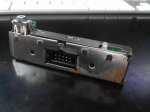
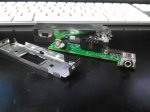
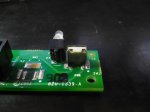
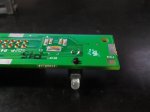
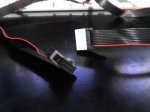
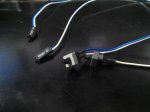
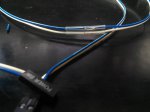
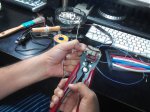
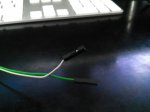
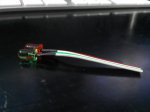
Out of curiosity, how are you taking photos with both of your hands in it? Have you recruited your wife as a build-assistant? If so, kudos to you!
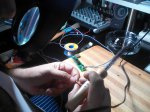
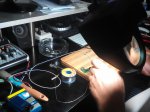
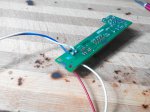
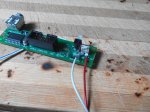
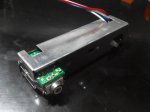
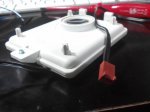
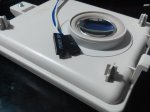
The red wire on the connector is pin 1, that is all it means, not it's the +5VDC pin. If you don't know what the pinout actually is, you will need to take a multimeter to it and find out.
As for your soldering skills... If your soldering iron has two temperatures (watt settings), use the lower one and you see how you have blobs of solder, well to fix that you just apply the iron to the point where you want to solder, press it down firmly (not crazy hard), wait a few seconds and then gently apply a touch of solder. You have about 5X too much right now but it won't harm anything.
You could have used that ribbon cable to pass all your signals and just cut the traces on the board and run wires there to keep it nice and clean looking. Stuff like that will come with experience. I personally think you are doing one hell of a good job with this conversion, just awesome.
the wire refused to stick to the pcb surface.
This might also help if you find yourself in this situation again:
http://en.wikipedia.org/wiki/Flux_(metallurgy)#Rosin_fluxes
It helps the solder flow. The solder will settle into the joint rather than balling up on top of it.
Glad that it works!
Yea, though I'd try a happier look. Maybe it's the tequila in me
Probably not, but it depends what features you need. Features that are nice to have which can only be implemented by the switch design (i.e. at the time of purchase):Do I need smart or managed switchers?
Any recommendations for Switchers, Routers and IP Cameras?
In my scenario what would you sacrifice? wireless N/AC capabilities or 3G? or should i get the best of both worlds by buying 2 devices?! leaving no chance of survival :) to my good old D-link DSL-2640T?
I guess I'll be able to achieve gigabit speeds between devices using gigabit switchers even if my router/modem is 10/100, if all my devices are connected to the switchers and all of them having gigabit NICs including game consoles, am I right?
Probably not, but it depends what features you need. Features that are nice to have which can only be implemented by the switch design (i.e. at the time of purchase):
- VLAN tagging or pass-through
- LACP
Even if you don't need those features now, if you don't have them when you buy the switch, you won't be able to use them.
VLAN pass-through is supported by some unmanaged switches. However other VLAN operations like tagging and segregation (where it only directs packets destined for certain VLANs to certain ports, thereby freeing traffic on other ports and the rest of the network) needs some sort of user interface, and this can only be accomplished by a smart switch.
LACP always needs a user interface only a smart switch can offer, but it may not be that useful in home situations (the whole "OMG-I-can-has-2-gigabit!" idea doesn't actually work).
I left out Jumbo Frame capability, which is supported by many unmanaged switches and probably all managed switches because this is an outdated idea that may or may not offer any advantages with more modern networking equipment.
You may want to look at pfSense. It turns an older computer into a powerful, configurable router and firewall. At first I didn't think it can handle 3G USB modems, but it can:
https://doc.pfsense.org/index.php/Known_Working_3G-4G_Modems
You can build a pfSense box out of an older computer, although it uses FreeBSD like FreeNAS it doesn't have the same high hardware requirements. You can use some neat new equipment though, I'm building this as a firewall/UTM but it would work equally well for pfSense:
http://ca.pcpartpicker.com/user/Fraoch/saved/Q9Pv6h
Amazingly if you have enough USB ports and are willing to put in some work you can also attach all USB print and storage devices to pfSense and have it share them over the network as well:
https://www.all4os.com/router/installing-the-cups-print-server-to-pfsense-2-1-and-2-x.html
https://code.google.com/p/pfsense-cacheboy/wiki/Pfsense_Samba
So if i have a 3G router It will operate the 3G USB modem software instead of the pc, and my wireless devices can get wireless internet connection with my Hackintosh turned off!?Yes, that's what they're designed to do, they use the USB modem as the WAN (Internet) source and act as any other router would after that.
You're welcome! Yes, networking can be very complicated. They sure like their acronyms!First, I'd like to thank you for your great efforts and detailed post, I found your post very educational.
I've been reading a lot in networking lately but there are times after excessive reading you feel everything is mixed up in your head lol
No, anything upstream of your gigabit switch only needs to handle your Internet connection, so that's 24 Mbps as you indicated. 10/100 equipment will work just fine.Luckily jumbo frame and VLAN is a standard options now in most of TP-Link smart switches like the one I mentioned in my post TP-LINK TL-SG108E
but in this case I should upgrade my router to a gigabit router as the packets will travel through the router too (please correct me if i'm wrong)
Many new ones are, but unfortunately not many TP-Link devices though. DD-WRT is very old-school and I hear rumours that it's past its prime - 5 GHz networking is spotty and it just isn't as cutting-edge as it used to be. OpenWRT and Tomato seem to be the ones to go to now.I was also reading about dd-WRT but my old D-Link router is not supported.
I won't be installing pfSense on that, although it would make a kicka$$ pfSense box. I have a Ubiquiti EdgeRouter Lite and I doubt that I could make a pfSense box that powerful, that small and that power-efficient. But I find the ERL's firewalling capabilities quite basic and I'd like to do more advanced things like network-wide ad blocking and advanced intrusion detection. I will probably be using Sophos for this, or possibly Untangle. Both use Snort intrusion detection, which likes its GHz, so I needed a CPU that's fast single-threaded.Good luck with your build, out of curiosity why you choose what i consider very powerful components for your pfSense ?
I don't use pfSense so I'm not sure. However I imagine it's identical to samba (CIFS) on FreeNAS. The main problem you'll have is permissions.what kind of issues you can have if you install Samba on pfSense?
Of course. In my mind the best protocol you can use is NFS. It's faster than CIFS and it's multi-threaded. It's seamless on Mac, Linux and BSD. Mac can also use CIFS just as seamlessly but it can be a bit slower. Best to do away with CIFS entirely if you don't use Windows.I rarely use Windows, can i share files with Macs?
So if i have a 3G router It will operate the 3G USB modem software instead of the pc, and my wireless devices can get wireless internet connection with my Hackintosh turned off!?
